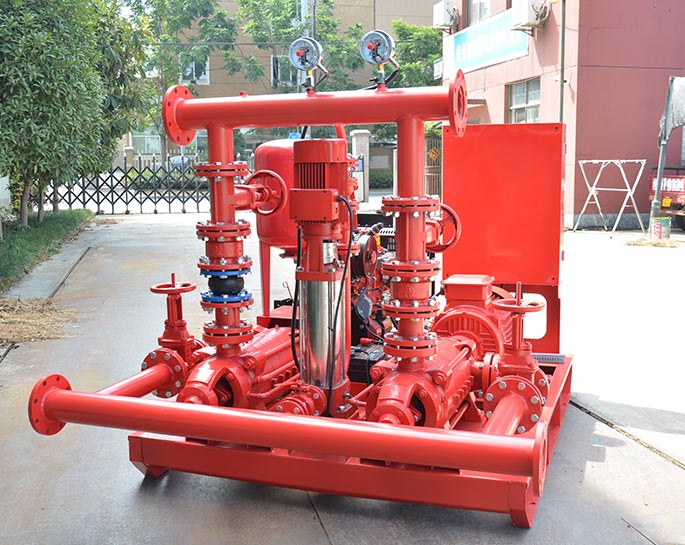Wearing parts and fire pump maintenance
Sep 15, 2020
Share:
Wearing parts and fire pumps maintenance:
1. The oil seal is a rubber product, which is easy to wear and age. Generally, new parts must be replaced.
2. The pump shaft material is generally carbon steel, but it is also easily damaged due to manufacturing quality, use or installation. Cracks, bends, journal wear, thread damage, etc. may occur on the pump shaft, and breakage may occur. If the damage is serious and cannot be repaired, replace the new shaft.
3. After the filler is used for a long time, it will become hard and lose its elasticity, which will cause the pump to leak. Generally, the new filler should be replaced.
4. The impeller is an important working part of the pump and is made of cast iron. It is also easily damaged due to manufacturing quality and use. Cracks may occur in the impeller, and holes or perforations may be formed on the surface due to cavitation, which may be thinned or eccentrically worn for a long time, or even crushed by debris. Some defects can be repaired; some defects cannot be repaired, new impellers should be replaced.
5. The pump casing is generally cast iron, which is prone to cracks due to mechanical or thermal stress. When the pump is subjected to the impact of cavitation during work or is frozen when the water in the pump casing is not drained in winter, it is also easy to be broken. If the damage is heavy and cannot be repaired, the new pump casing should be replaced.
6. The mouth ring is also called the minus leakage ring or wearing ring. It is one of the most wearable parts in the pump. It can be repaired after wear and can be replaced with new ones. When replacing the new minus leakage ring, the inner diameter of the electric fire pump should be configured according to the outer diameter of the impeller inlet. If the outer diameter of the impeller inlet is worn, the electric fire pump can be turned to eliminate the groove and ellipse, and then the inner diameter minus leakage ring is configured. The outer diameter of the impeller inlet can be turned three times.
7. The bearing bush of the sliding bearing is cast from copper-tin alloy. It has poor wear resistance and is one of the most vulnerable parts for wear and burnout. The bearing bush can be repaired or replaced with new ones. Rolling bearings generally have an average service life of 5,000 hours, but they are improperly installed, have long service life or poor maintenance, and are also prone to wear or damage. In addition to the replacement of the individual parts of the rolling bearing, it is generally necessary to replace the integral part.
We propose that fire pumps should pay more attention to maintenance, which can extend the service life and reduce the cost of use.
1. The oil seal is a rubber product, which is easy to wear and age. Generally, new parts must be replaced.
2. The pump shaft material is generally carbon steel, but it is also easily damaged due to manufacturing quality, use or installation. Cracks, bends, journal wear, thread damage, etc. may occur on the pump shaft, and breakage may occur. If the damage is serious and cannot be repaired, replace the new shaft.
3. After the filler is used for a long time, it will become hard and lose its elasticity, which will cause the pump to leak. Generally, the new filler should be replaced.
4. The impeller is an important working part of the pump and is made of cast iron. It is also easily damaged due to manufacturing quality and use. Cracks may occur in the impeller, and holes or perforations may be formed on the surface due to cavitation, which may be thinned or eccentrically worn for a long time, or even crushed by debris. Some defects can be repaired; some defects cannot be repaired, new impellers should be replaced.

6. The mouth ring is also called the minus leakage ring or wearing ring. It is one of the most wearable parts in the pump. It can be repaired after wear and can be replaced with new ones. When replacing the new minus leakage ring, the inner diameter of the electric fire pump should be configured according to the outer diameter of the impeller inlet. If the outer diameter of the impeller inlet is worn, the electric fire pump can be turned to eliminate the groove and ellipse, and then the inner diameter minus leakage ring is configured. The outer diameter of the impeller inlet can be turned three times.
7. The bearing bush of the sliding bearing is cast from copper-tin alloy. It has poor wear resistance and is one of the most vulnerable parts for wear and burnout. The bearing bush can be repaired or replaced with new ones. Rolling bearings generally have an average service life of 5,000 hours, but they are improperly installed, have long service life or poor maintenance, and are also prone to wear or damage. In addition to the replacement of the individual parts of the rolling bearing, it is generally necessary to replace the integral part.
We propose that fire pumps should pay more attention to maintenance, which can extend the service life and reduce the cost of use.






